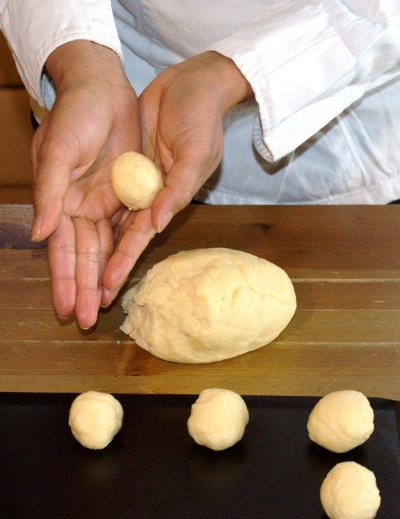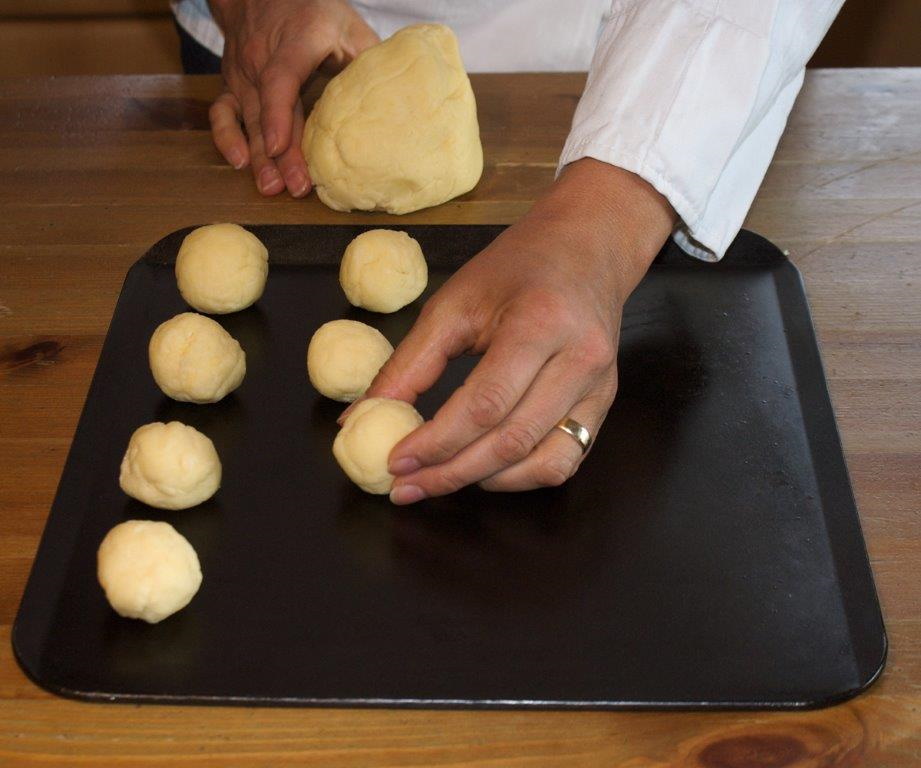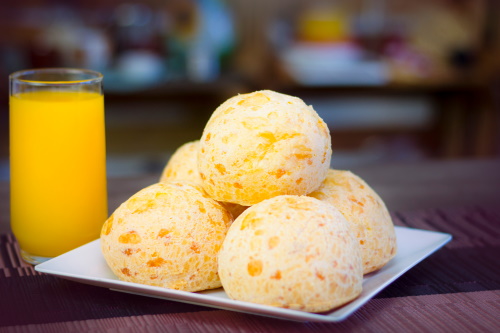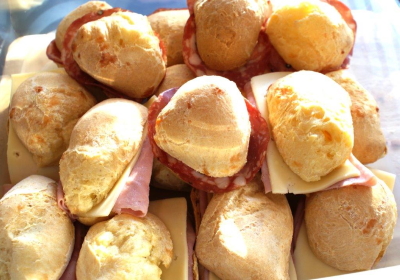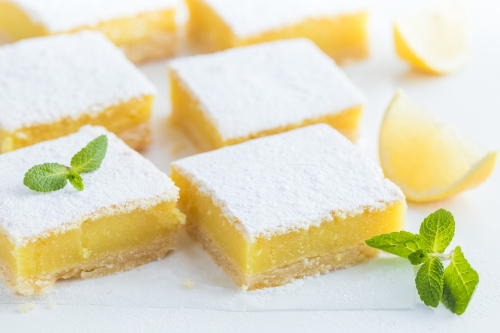These lovely little mouthfuls are called pão de queijo – literally ‘cheese breads’ – in their country-of-origin Brazil. They have a very delicate cheese flavour, a crisp outer crust, and a chewy airy texture which makes them most enjoyable.
They’re great on their own as a snack at any time of day, or served as a savoury nibble with cheeses or with soup, or at breakfast with butter and jam. They can also be a substitute for bread when making sandwiches. They are perhaps best enjoyed warm from the oven, but also tasty served cold as canapes. I really like them with baked Camembert.
I’ve been producing this authentic Dough Balls Mix in the UK since 2005. This was the first product that I ever created when I started Isabel’s. They bring great memories of my childhood and time spent with good friends. They are a hugely popular snack back in Brazil, as they are incredibly moreish. This humble snack holds a very special place in the heart of all Brazilian people. And they seem to spread this love everywhere they go… And best of all, they are naturally gluten free. We also produce a small pack of the Dough Balls mix dairy free for anyone avoiding dairy products.
The basic ingredients
The ingredients look to be mainly tapioca starch, but actually the Dough Balls mix is an expert blend of a few different varieties of the Cassava starch. Some of these ingredients are quite expensive indeed. Cassava starches can be tricky to use as they are not very forgiving if you add a little too much or too little milk or water, or a smaller egg, or a combination of both of these. It is very important to use the amounts as advised on the packaging, unless you’re an expert in making them already. It is important to use an accurate scale, especially if you are making the Dough Balls for the first time. Essentially, to make a good dough you need, the Isabel’s Dough Balls mix, some type of milk (if plant-based, high protein variety, such as soya or almond milk will give better results – because the flour loves protein), egg(s), grated cheese and some vegetable oil.
Has your dough been kneaded enough?
If you have measured all your ingredients correctly and kneaded your dough, how can you be sure that you have kneaded the dough enough?
The dough should be pliable, not sticky and it will be easy to roll and shape it. If it is sticky then you may have added to much liquid to the mix. It will still bake okay, but the dough will be sticky to handle.
If your dough feels a little dry when kneading, add little more oil or a bit more egg rather than more milk or water. If the dough is not quite coming together then keep kneading. You could use the help of a food processor to do this job for you if you wish – it is a lot less effort.
What’s the perfect size for making the Dough Balls?
Depending on which pack size you have purchased, you can make either 15 x 20g or 30 x 20g Dough Balls (the packs states less (12-24)).
But you can also be flexible on sizing. You could for example make them cocktail size 15g, snack size 20-25g or lunch size 50g-65g. You decide – but please note, when making larger dough balls, e.g., the lunch size, do not roll the dough into a large ball. Instead, it must be shaped flatter and not as high to allow the bread to bake properly and cook well inside. You can shape the dough any way you want, round or like a sub sandwich, as long as it is not too high.
Cow’s milk or plant base
Milk adds softness, colour and flavour to the dough. To allow more people with gluten and dairy intolerance to use our mixes we removed the milk content from the formula of the 125g packs. Please rest assured that this was only a very small part of the recipe and will not have impact on the final results at all. You can use fresh cow’s milk or powdered milk or plant-based milk to make the dough as directed on the packaging. However, when using plant-based milk, I would recommend using a high protein one. This is because this flour blend prefers high protein milk and will provide better results with it. Please note that the 250g packs of the Dough Balls Mix still contains milk
What else can I add to my dough?
Isabel’s Dough Balls Mix is the perfect base for adding your own creativity. So why not try using other type of cheeses or a mix of cheeses, such as Parmesan, mozzarella, and stronger cheddar. Add fresh herbs too, such as oregano or chives. What about chilli flakes? Add finely chopped and cooked chorizo or smoked pancetta in the dough. Mixed seeds or nuts will add not only great flavour, but also add nutrition to your dough balls.
Can I fill the Dough Balls?
Yes, you can! Place a cube of your favourite cheese with fresh herbs inside each dough ball to create an extra special nibble. What about place a piece of Camembert, garlic and a slice of chorizo inside the dough balls? You could also add a piece of cooked meat inside the dough balls. The dough balls are also really enjoyable served with jams or caramel.
Freezing the dough
The shaped, unbaked dough are perfect for freezing. Roll the dough in the preferred size, place them on a tray, cover with cling film and place in the freezer for about 2-3 hours. Store the dough balls in freezer bags or tupperware. Bake direct from frozen when required in just 25 minutes depending on the size. Use within 2 months.
Chewy or gooey syndrome
I recommend using an accurate kitchen scale to weigh all the liquid ingredients. When you become more experienced in working with Cassava starches you will be able to make adjustments to correct any issues you may come across when preparing these tasty Dough Balls.
It is very important to be mindful of the of the moisture content of other ingredients you might be adding to the mix. Especially, if you are making the Dough Balls vegan and will be adding cooked root vegetables to the dough. It is important to consider the amount of water that will be already inside the root vegetables from the cooking process when you add them to the mix. You might need to adjust accordingly and reduce the amount of milk when making the dough.
If you are not sure how much milk to add, I would suggest adding the milk little by little whilst bringing the dough together, and when you feel you have a bit of a dough, stop adding the milk and start kneading. This flour blend is not like wheat flours which will eventually would absorb the extra liquid. It is more like when cooking rice, if you add too much water, it will make the rice too soft and mushy. In case of the dough balls, it will make them gooey or chewy. So better to add liquid ingredients gradually and with care.
Always check the weight of the eggs you’ll be using, because the egg could be on the smaller side and this will have a huge impact on your ability to make the perfect dough balls.
Note that on the packaging we suggest using one egg and this quantity will make excellent dough balls. However, if you would like to add more nutrition to your dough or make them lighter or rise more you could add 2 eggs instead. Again, please remember to reduce the milk amount otherwise your dough could become sticky and hard to handle.

